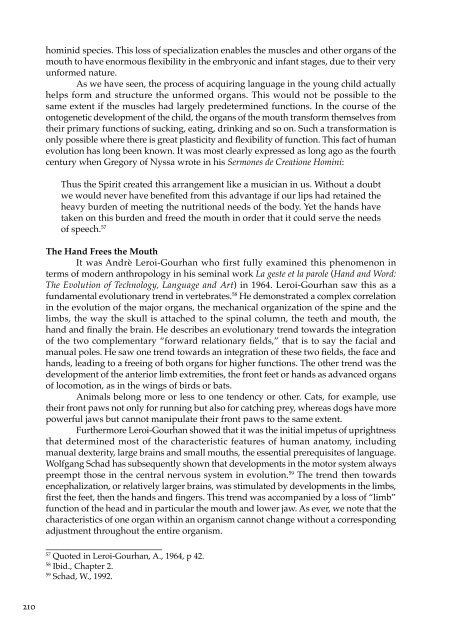The Spirit in Human Evolution - Waldorf Research Institute
The Spirit in Human Evolution - Waldorf Research Institute
The Spirit in Human Evolution - Waldorf Research Institute
Create successful ePaper yourself
Turn your PDF publications into a flip-book with our unique Google optimized e-Paper software.
hom<strong>in</strong>id species. This loss of specialization enables the muscles and other organs of the<br />
mouth to have enormous flexibility <strong>in</strong> the embryonic and <strong>in</strong>fant stages, due to their very<br />
unformed nature.<br />
As we have seen, the process of acquir<strong>in</strong>g language <strong>in</strong> the young child actually<br />
helps form and structure the unformed organs. This would not be possible to the<br />
same extent if the muscles had largely predeterm<strong>in</strong>ed functions. In the course of the<br />
ontogenetic development of the child, the organs of the mouth transform themselves from<br />
their primary functions of suck<strong>in</strong>g, eat<strong>in</strong>g, dr<strong>in</strong>k<strong>in</strong>g and so on. Such a transformation is<br />
only possible where there is great plasticity and flexibility of function. This fact of human<br />
evolution has long been known. It was most clearly expressed as long ago as the fourth<br />
century when Gregory of Nyssa wrote <strong>in</strong> his Sermones de Creatione Hom<strong>in</strong>i:<br />
Thus the <strong>Spirit</strong> created this arrangement like a musician <strong>in</strong> us. Without a doubt<br />
we would never have benefited from this advantage if our lips had reta<strong>in</strong>ed the<br />
heavy burden of meet<strong>in</strong>g the nutritional needs of the body. Yet the hands have<br />
taken on this burden and freed the mouth <strong>in</strong> order that it could serve the needs<br />
of speech. 57<br />
<strong>The</strong> Hand Frees the Mouth<br />
It was Andrè Leroi-Gourhan who first fully exam<strong>in</strong>ed this phenomenon <strong>in</strong><br />
terms of modern anthropology <strong>in</strong> his sem<strong>in</strong>al work La geste et la parole (Hand and Word:<br />
<strong>The</strong> <strong>Evolution</strong> of Technology, Language and Art) <strong>in</strong> 1964. Leroi-Gourhan saw this as a<br />
fundamental evolutionary trend <strong>in</strong> vertebrates. 58 He demonstrated a complex correlation<br />
<strong>in</strong> the evolution of the major organs, the mechanical organization of the sp<strong>in</strong>e and the<br />
limbs, the way the skull is attached to the sp<strong>in</strong>al column, the teeth and mouth, the<br />
hand and f<strong>in</strong>ally the bra<strong>in</strong>. He describes an evolutionary trend towards the <strong>in</strong>tegration<br />
of the two complementary “forward relationary fields,” that is to say the facial and<br />
manual poles. He saw one trend towards an <strong>in</strong>tegration of these two fields, the face and<br />
hands, lead<strong>in</strong>g to a free<strong>in</strong>g of both organs for higher functions. <strong>The</strong> other trend was the<br />
development of the anterior limb extremities, the front feet or hands as advanced organs<br />
of locomotion, as <strong>in</strong> the w<strong>in</strong>gs of birds or bats.<br />
Animals belong more or less to one tendency or other. Cats, for example, use<br />
their front paws not only for runn<strong>in</strong>g but also for catch<strong>in</strong>g prey, whereas dogs have more<br />
powerful jaws but cannot manipulate their front paws to the same extent.<br />
Furthermore Leroi-Gourhan showed that it was the <strong>in</strong>itial impetus of uprightness<br />
that determ<strong>in</strong>ed most of the characteristic features of human anatomy, <strong>in</strong>clud<strong>in</strong>g<br />
manual dexterity, large bra<strong>in</strong>s and small mouths, the essential prerequisites of language.<br />
Wolfgang Schad has subsequently shown that developments <strong>in</strong> the motor system always<br />
preempt those <strong>in</strong> the central nervous system <strong>in</strong> evolution. 59 <strong>The</strong> trend then towards<br />
encephalization, or relatively larger bra<strong>in</strong>s, was stimulated by developments <strong>in</strong> the limbs,<br />
first the feet, then the hands and f<strong>in</strong>gers. This trend was accompanied by a loss of “limb”<br />
function of the head and <strong>in</strong> particular the mouth and lower jaw. As ever, we note that the<br />
characteristics of one organ with<strong>in</strong> an organism cannot change without a correspond<strong>in</strong>g<br />
adjustment throughout the entire organism.<br />
_________________________<br />
57<br />
Quoted <strong>in</strong> Leroi-Gourhan, A., 1964, p 42.<br />
58<br />
Ibid., Chapter 2.<br />
59<br />
Schad, W., 1992.<br />
210
















